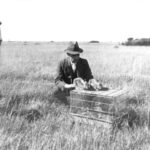“Pueblo Revolt 1680” by Loren Mozley. Public Domain.
The horse is thought of as a symbol of the American West, but when and how domesticated horses arrived has been a matter of controversy. Lakota oral histories described the arrival of the horse occurring prior to the arrival of the Spanish colonizers. However, the Spanish (and Western historians) believed these horses were descendents of those left behind after the Spanish were driven out of the Southwest during the Pueblo Revolt in 1680.
While there are gaps and biases in the historical record which prevent us from definitively answering this question, there is another potential source: the genetic sequences from horses both alive and dead! Genetic sequences provide a set of instructions for each cell. This genetic sequence is copied and carried on to subsequent generations. However, this copying process isn’t perfect, and each time, a few mistakes are made and carried to the next generation of offspring. We can compare the genetic sequences of these organisms to measure how related they are. By developing computer models of how these small mistakes accumulate over time, we can build an evolutionary tree (phylogeny). A phylogenetic tree is a diagram that illustrates the evolutionary history of these sequences, much like a family tree.
But how does this work? How are we able to build an evolutionary tree describing these animals’ history without having samples from this time? We start simple. We build a phylogenetic tree based on just the number of differences between the genetic sequences. The more differences, the more distantly related they are. This sort of rough phylogeny provides us with a tree that describes how related the samples are but doesn’t provide insight into how long ago they might have shared a common ancestor. In 2006, Cristina Luís and others applied this simpler phylogenetic analysis to show that wild North American horse breeds were most closely related to Spanish horses. However, this doesn’t quite answer the question of which history was correct, the Spanish or Lakota’s. Did the horse arrive before or after 1680?
At its most basic, we can look at how often those genetic mistakes tend to occur in horses and use this to “scale” our phylogenetic tree to the amount of time that has passed. For example, in humans, there are around 64 new differences in each generation. If we find around 6400 differences between a pair of humans, this would mean the two shared an ancestor around 98 great-grandparents ago (or 2,000-3,000 years ago given that a generation is around 20-30 years for humans). However, not all mutations are created equal! We have additional computer models which help us adjust for how common different types of mutations are, allowing us to provide even more accurate estimates for the genetic distances we use to build our trees. As for the tree-building process itself, we have more advanced models which help us build more accurate trees over longer timescales. But let’s get back to the horses…
Recently, a huge, interdisciplinary study involving many diverse experts, including geneticists, archaeologists, and indigenous historians and scientists, was published. They incorporated new data, more advanced methods for phylogenetic analysis, historical accounts, and archaeological evidence to answer, once and for all: when was the horse reintroduced to the Southwest? The authors built a more precise evolutionary tree, which was scaled to time. They found that there was no evidence of Late Pleistocene North American horses mixing with domestic horses in North America, nor did they find the horses to be related to the breeds of horses which likely would have been brought over by the Vikings when they made landfall in the late 10th century. So this reconfirms the Spanish reintroduction of horses into the American Southwest. But what about the controversy?! Did the Spanish or Spanish horses meet indigenous peoples first?
Skeleton of a horse in motion, chromolithograph, 1870. Creative Commons Attribution (CC BY 4.0)
Unfortunately, the phylogenetic analysis was not sufficiently precise to estimate exactly when horses were reintroduced to the Southwest. While phylogenetic models can help rule out theories about Viking or Late Pleistocene ancestry, the difference between Lakota and Spanish historians’ accounts is just 100 years or so. This is too short of a window too far back in time to make a definitive estimate. Instead, they ended up needing to investigate further using horse skeletons from around the time of the Pueblo Revolt. Archaeologists on the team measured the minerals found in these horse skeletons and compared them to the minerals found throughout the area. They found that these minerals best matched up with minerals that would have been found in plants far more North than where the Spanish were at the time. Given that the horse skeletons were dated to the mid-17th century, this analysis firmly places the arrival of horses before the Pueblo Revolt in 1680. In other words, the oral histories of the Lakota align most closely with the archaeological evidence. Instead of leaving behind horses after the Pueblo Revolt, it’s more likely that horses had already developed a feral population or were traded along indigenous trade networks prior to the Spanish colonists arriving in the American Southwest.
Phylogenetics allows us to roll back the clock, using our knowledge of genetic sequence data to infer ancestry and investigate the emergence of traits over time. Through phylogenetic analysis, we can build evolutionary family trees that answer questions like “when were dogs domesticated?” or “where does corn come from?”. While in this case, phylogenetics was unable to solve the mystery alone, phylogenetic analysis, combined with historical and archeological methods, has finally laid to rest the Western historical claim that fleeing Spanish colonizers is what brought the horse to the American Southwest.
About the Author
Guppy is a third-year bioinformatics Ph.D. student. They have a master's degree in statistics from NC State University, an undergraduate degree in mathematics from Clemson University, and spent a few years working for TIAA as a data scientist before heading to UGA. Their research focuses on studying the evolution and spread of SARS-CoV-2 and highly pathogenic avian influenza using statistical and computational methods. Outside of the lab, Guppy can be found bouldering at Active Climbing, reading science fiction and history, going on hikes with their puppy, Zoya, roasting and drinking coffee, or playing tabletop role-playing games like Dungeons and Dragons.
-
Guppy Stotthttps://athensscienceobserver.com/author/guppy-stott/February 29, 2024
-
Guppy Stotthttps://athensscienceobserver.com/author/guppy-stott/November 30, 2022
-
Guppy Stotthttps://athensscienceobserver.com/author/guppy-stott/November 16, 2021








